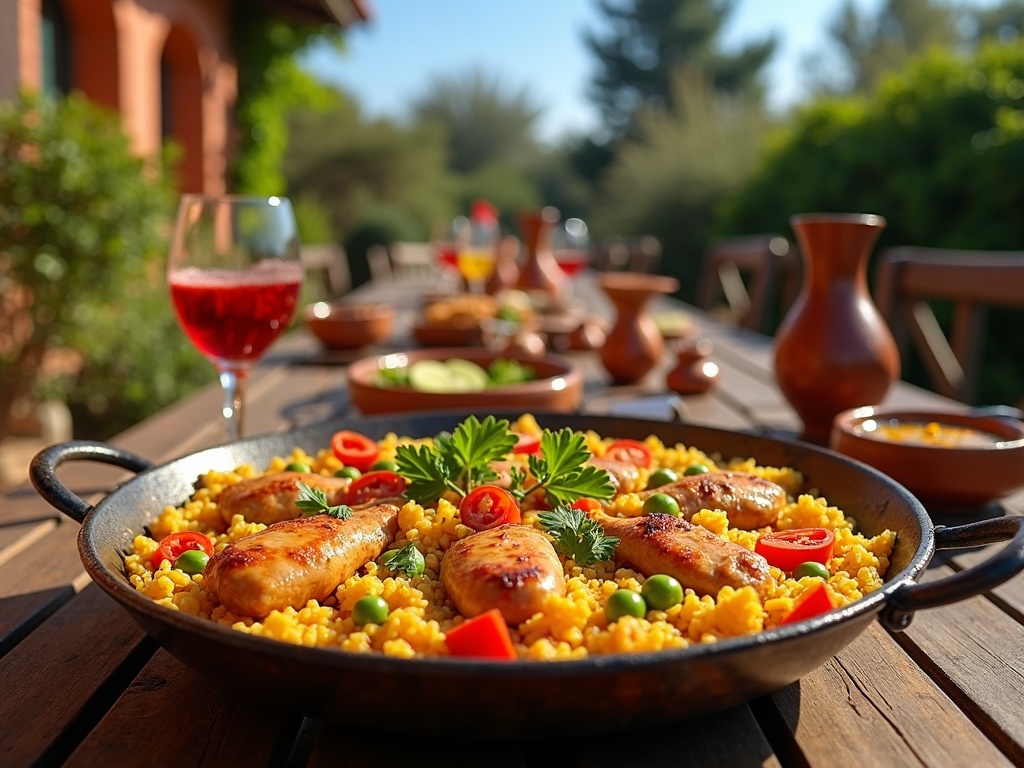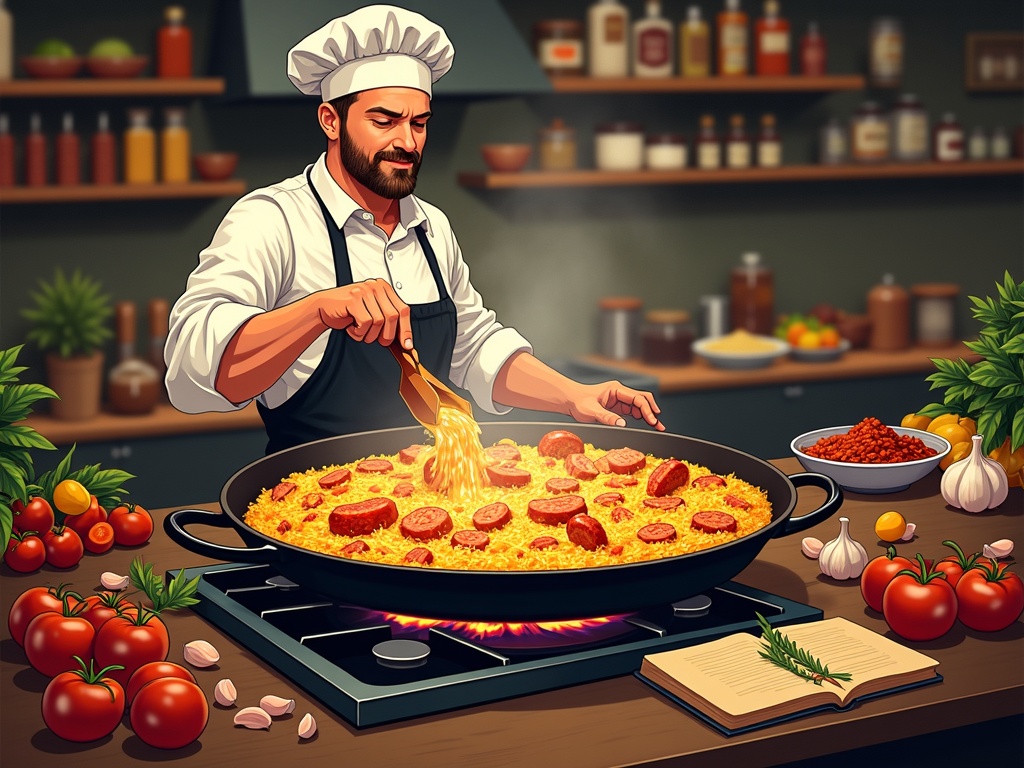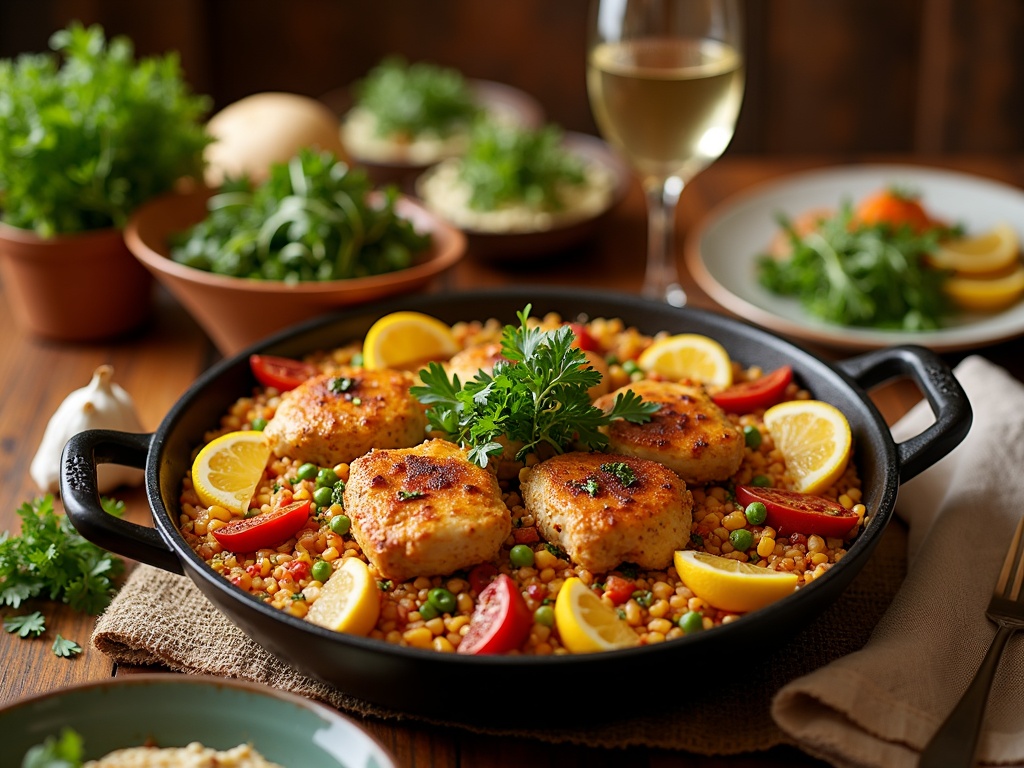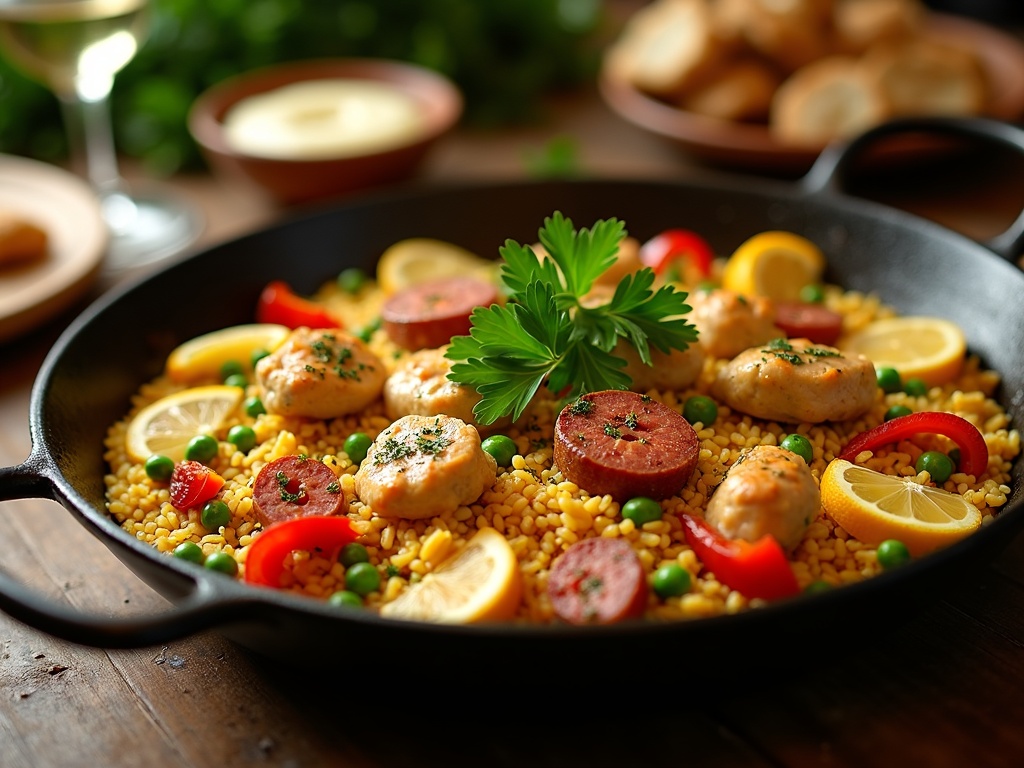Chicken and chorizo paella represents the evolution of traditional Spanish cuisine, moving from a simple farmer’s dish to a globally loved meal that keeps its cultural importance. This tasty rice dish mixes smoky chorizo and tender chicken with saffron-infused rice, creating a perfect blend of authentic Spanish flavors while showing how regional changes have boosted its worldwide appeal.
Find In This Article
Key Takeaways
- Traditional paella originated in Valencia with humble ingredients like rabbit and snails, evolving to include variations like chicken and chorizo as it spread beyond Spain.
- Essential ingredients include Arborio or Bomba rice, Spanish chorizo, saffron threads, and bell peppers, best cooked in a wide, shallow paella pan.
- The cooking technique requires patience—start with high heat for sautéing meats, reduce to a gentle simmer, and avoid stirring to develop the prized crispy bottom layer called socarrat.
- The dish provides a balanced nutritional profile with approximately 600 calories per serving and can be adapted for various dietary needs.
- Paella is best served family-style with simple accompaniments like a light salad and paired with Spanish wines such as Albariño or rosé.
A Taste of Spanish Tradition: Origins and Evolution
I’ve always been fascinated by how paella has transformed while maintaining its cultural importance in Spanish cuisine. The dish we know today as chicken and chorizo paella has roots that stretch back centuries to the eastern Spanish region of Valencia.
From Humble Beginnings to Global Icon
Traditional Valencian paella was a humble farmer’s dish cooked over an open fire. Unlike today’s seafood or chicken versions, authentic Valencian paella originally contained rabbit and snails, along with local vegetables and rice. These ingredients reflected what was readily available to rural workers who needed sustaining meals after long days in the fields.
As paella spread beyond Valencia, coastal regions added seafood while inland areas incorporated different meats. This regional adaptation led to the creation of many varieties, including the now-popular chicken and chorizo combination. The dish’s flexibility allowed it to evolve while maintaining its core identity—a flavorful rice dish cooked in a wide, shallow pan.
Cultural Impact and Modern Interpretations
Paella holds tremendous cultural significance in Spain. It’s not just food—it’s a celebration of gathering, family, and tradition. Sunday paella lunches remain an important ritual in many Spanish households, where the preparation is often as important as the meal itself.
The inclusion of chorizo in paella represents one of the more significant evolutions of the dish. Though some purists might argue against this addition, it’s become incredibly popular outside Spain. The smoky, paprika-infused chorizo adds a distinctive flavor that complements the saffron-tinged rice beautifully, creating a dish that pays homage to tradition while embracing change.
Today’s versions often include:
- Chicken thighs instead of rabbit for accessibility and broader appeal
- Chorizo for a depth of flavor and smokiness
- Bell peppers and peas for color and texture
- Saffron as the signature aromatic element
- Bomba or Calasparra rice varieties for authentic texture
The chicken and chorizo combination has become particularly beloved worldwide, offering an accessible entry point to Spanish cuisine. It’s a perfect example of how traditional dishes can evolve across borders while keeping their essence intact.
For those interested in exploring other Spanish-inspired dishes, chorizo pasta offers another delicious way to enjoy the distinctive flavor of Spanish sausage in a different context.

Perfect Your Paella: Essential Ingredients and Tools
I’ve found that creating an authentic chicken and chorizo paella requires both the right ingredients and proper equipment. Let’s break down what you’ll need to create this delicious Spanish dish in your own kitchen.
Key Ingredients for Authentic Flavor
The foundation of any great paella starts with the right rice. Arborio or Bomba rice is essential as these short-grain varieties absorb liquid beautifully while maintaining their structure. The short-grain nature allows the rice to soak up all those incredible flavors without turning mushy.
Spanish chorizo adds a distinctive flavor profile with its smoked paprika and garlic spices. This cured sausage releases oils during cooking that infuse the entire dish with richness. When paired with chicken thighs (which stay juicier than breast meat), you get a perfect protein combination.
The aromatic and colorful components that bring paella to life include:
- Bell peppers for sweetness and vibrant color
- Fresh or frozen peas for a pop of green
- Saffron threads for that distinctive yellow hue and earthy flavor
- Minced garlic and onion for the aromatic base
- Smoked paprika for depth and authentic Spanish character
For a variation on this classic combination, you might want to try chorizo in pasta dishes which offers a similar flavor profile in a different format.
Essential Tools for Perfect Results
The right equipment makes all the difference when cooking paella. Traditionally, a paella pan (called a “paellera”) with its wide, shallow shape allows rice to cook evenly and develop that prized socarrat—the crispy bottom layer that’s considered a delicacy.
If you don’t have a specialized pan, a large skillet with enough surface area works well too. The key is ensuring your pan has:
- Sufficient width to spread rice in a thin layer
- Good heat distribution for even cooking
- Enough depth to contain the liquid and ingredients
For stirring and serving, I rely on a wooden spoon that won’t scratch the cooking surface, accurate measuring cups for proper liquid-to-rice ratios, and a good ladle for adding stock gradually.
Creating a traditional paella recipe at home might seem challenging at first, but with these essential ingredients and tools, you’ll be crafting authentic Spanish flavors in no time.
Master the Cooking Method
Cooking paella is a delightful process that requires some patience and technique. The total time to prepare this chicken and chorizo paella ranges from 45-60 minutes, with about 30 minutes of active cooking time. I’ve refined my approach over the years to create the perfect balance of flavors and that coveted crispy bottom layer.
Perfect Timing and Temperature Control
I always start cooking paella on medium-high heat to sauté the chicken and chorizo properly. This initial high heat helps lock in the flavors and creates a tasty foundation for the dish. After adding the rice and liquid, I immediately reduce the heat to low for a gentle simmer. This temperature change is critical – too hot and the bottom burns before the rice cooks; too cool and you’ll miss out on developing complex flavors.
The rice typically needs 18-20 minutes to cook properly. During this time, resist the urge to stir! This hands-off approach allows the rice to cook evenly and helps create the socarrat – that deliciously crispy layer at the bottom that’s considered the crown jewel of a proper paella.
For developing that perfect socarrat, I increase the heat slightly during the final 2 minutes of cooking. Listen carefully for a subtle crackling sound – that’s your sign that magic is happening at the bottom of the pan. If you’re using an electric stovetop, you might need to rotate the pan occasionally for even heat distribution. Gas stovetops provide more consistent heat, making them ideal for paella cooking.
Different stovetops require slight adjustments:
- Electric coils: Use a heat diffuser for more even cooking
- Gas ranges: Provide ideal control, but watch flame spread under the pan
- Induction: Extremely precise temperature control but may need longer for socarrat formation
- Glass top: Heat slowly and use slightly lower temperatures
Once your paella is cooked, don’t rush to serve it! A 5-10 minute resting period with the pan covered allows the flavors to settle and meld together beautifully. This rest is also crucial for moisture redistribution throughout the rice.
I often serve my paella with additional chorizo dishes on the side for guests who love that rich, smoky flavor. For a more traditional approach, you can explore a classic paella recipe that focuses on seafood components rather than chicken.
“`
https://www.youtube.com/watch?v=dQw4w9WgXcQ
“`

Nutritional Benefits and Healthy Adaptations
Paella is more than just a delicious Mediterranean dish—it’s packed with nutritional benefits that make it a satisfying and relatively balanced meal option. A standard serving of chicken and chorizo paella contains approximately 600 calories, making it suitable as a main course that won’t break your calorie bank.
The macronutrient breakdown offers a good balance with 25g of protein per serving, which helps with muscle maintenance and keeps you feeling full longer. The dish contains about 15g of fat, primarily from the olive oil and chorizo, while providing 85g of carbohydrates mainly from the rice. Each serving also delivers 3g of fiber, contributing to digestive health, though I’d suggest adding extra vegetables to boost this further.
One consideration is the sodium content, which sits at around 800mg per serving—about one-third of the recommended daily intake for adults. The good news is that a single batch typically serves 4-6 people, making it perfect for family dinners or meal prep for the week.
Healthier Adaptations
I’ve found several ways to make traditional paella recipes more health-conscious without sacrificing flavor:
- Substitute regular chorizo with turkey chorizo to cut fat content by nearly half
- Use brown rice instead of white for increased fiber and nutrients
- Reduce oil to 2 tablespoons and use a non-stick pan
- Add extra vegetables like bell peppers, peas, and artichokes
- Use low-sodium broth and reduce added salt
- Include more seafood like shrimp or mussels in place of some meat
The chicken in paella provides excellent lean protein, which supports muscle growth and repair. Chicken breast in particular is low in fat while delivering essential B vitamins, especially niacin which helps convert food into energy.
Special Dietary Considerations
For those with specific dietary needs, I can recommend these modifications:
The beauty of paella is its adaptability. For gluten-free diets, the dish is naturally compliant—just verify your broth and seasonings are gluten-free. If you’re watching carbohydrates, cauliflower rice makes an excellent substitute for traditional rice, cutting carbs by more than half.
For those concerned about cholesterol, removing the skin from the chicken before cooking can significantly reduce the fat content. You might also consider using plant-based chorizo alternatives that mimic the smoky flavor but contain less saturated fat.
The sodium content can be further reduced by making your own seasoning blend rather than using pre-packaged options. A simple mix of saffron, paprika, garlic powder, and oregano delivers authentic flavor without the added salt.
For vegetarians, replace the meat proteins with chickpeas, butter beans, or even cubed firm tofu marinated in paprika and garlic. These alternatives absorb the rich flavors of the dish while maintaining a satisfying texture.
I’ve found that adding a squeeze of fresh lemon juice just before serving not only brightens the flavor but also helps your body absorb the iron from the plant-based ingredients in the dish.
By making these thoughtful adaptations, you can enjoy this Spanish classic with improved nutritional benefits while still savoring all the traditional flavors that make paella so beloved across the world.
Perfect Pairings and Serving Ideas
I’ve found that the robust flavors of chicken and chorizo paella truly shine when accompanied by thoughtful pairings and presentation. This Spanish masterpiece deserves companions that complement rather than compete with its complex flavor profile.
Beverage and Garnish Companions
When serving paella, I always consider what drinks will enhance the experience. Albariño, a crisp Spanish white wine with notes of citrus and stone fruit, cuts through the richness of the dish beautifully. Its slight salinity perfectly complements the saffron and seafood elements if you’ve included them. For those who prefer something with a bit more color, a fruity rosé provides enough body to stand up to the chorizo while refreshing the palate between bites.
Presentation makes a significant difference in the overall dining experience. I garnish my chicken and chorizo paella with fresh parsley scattered across the top, adding a bright pop of color and fresh herbaceous notes. Lemon wedges arranged around the edge of the pan not only look attractive but offer diners the option to add a squeeze of citrus acidity that lifts the entire dish.
An aioli served on the side provides a creamy, garlicky complement that many guests appreciate. The cool, rich sauce creates a delicious contrast to the warm, spiced rice. I make mine with fresh garlic and good quality olive oil for an authentic touch.
Creating the Complete Meal Experience
Paella is inherently a communal dish, and I’ve found that family-style serving enhances this aspect wonderfully. I bring the entire paella pan to the table and let everyone serve themselves, encouraging conversation and connection. This traditional approach honors the Spanish roots of the dish and creates a memorable dining experience.
For a balanced meal, I pair paella with simple, fresh accompaniments. A light salad with crisp greens, perhaps some arugula dressed with a sherry vinaigrette, provides a refreshing counterpoint to the hearty main dish. I sometimes include thinly sliced fennel or orange segments in the salad for an extra Mediterranean touch.
Vegetable sides that complement paella without overwhelming it include:
- Grilled asparagus with a touch of olive oil and sea salt
- Roasted bell peppers dressed with sherry vinegar
- Sautéed green beans with almond slivers
- Simple tomato salad with red onion and herbs
When planning a more elaborate Spanish-themed dinner, I often start with simple tapas like marinated olives or pan con tomate before serving the paella as the star attraction. For dessert, something light and citrusy like a lemon sorbet provides the perfect ending.
The beauty of chorizo in this dish is how its smoky paprika flavors infuse the rice, creating a foundation for the other ingredients to build upon. This same quality makes it important to consider balance when planning accompaniments.
I’ve discovered that keeping side dishes relatively simple allows the paella to remain the focal point of the meal. The complementary elements should enhance rather than distract from the main attraction, creating a harmonious dining experience that transports you straight to the Spanish countryside.

Sources:
Paella: A Culinary Journey – Gastronomy Journal
Understanding Paella: History, Ingredients, and Cooking Techniques – Spanish Culinary Classics
Nutritional Overview of Traditional Spanish Dishes – National Nutrition Institute

